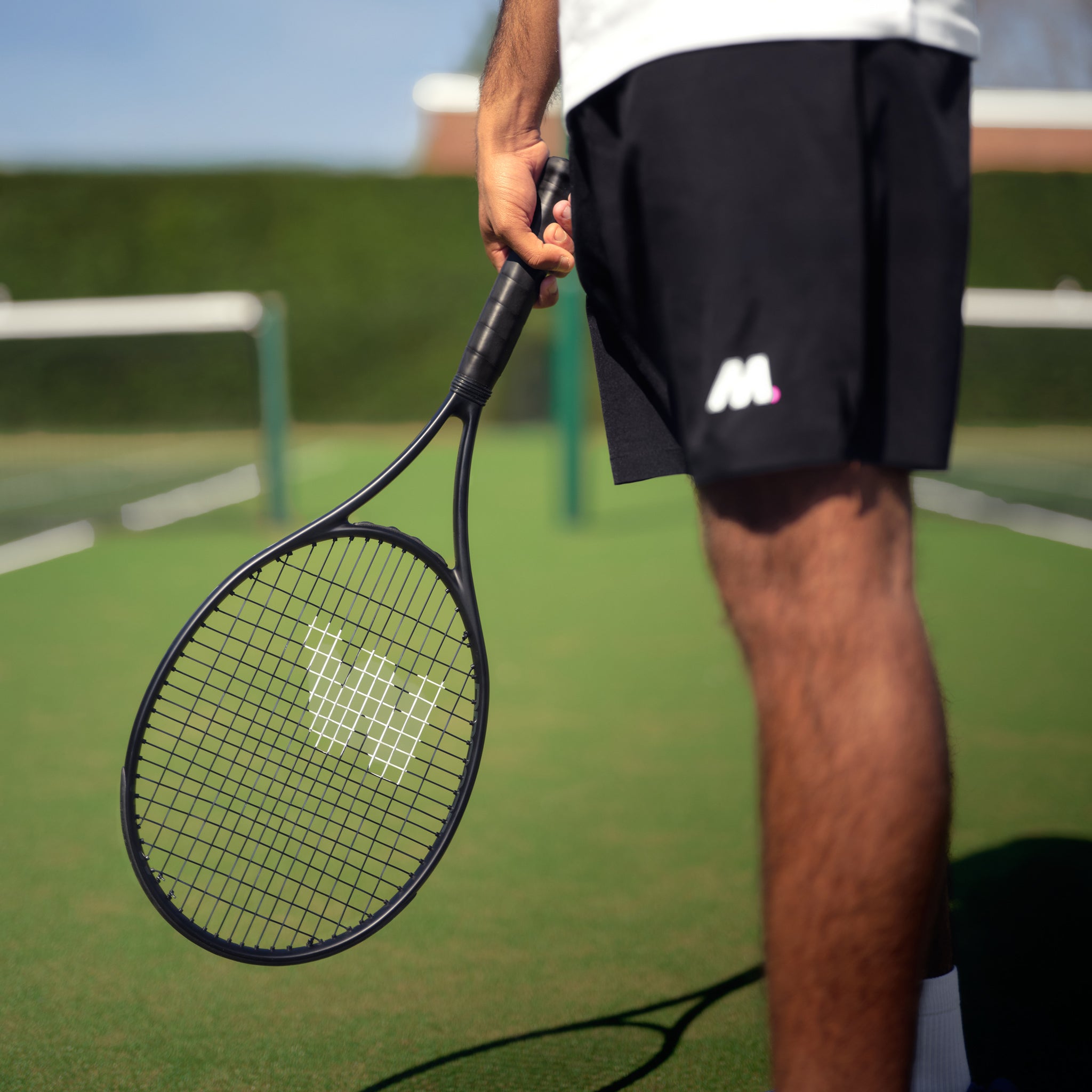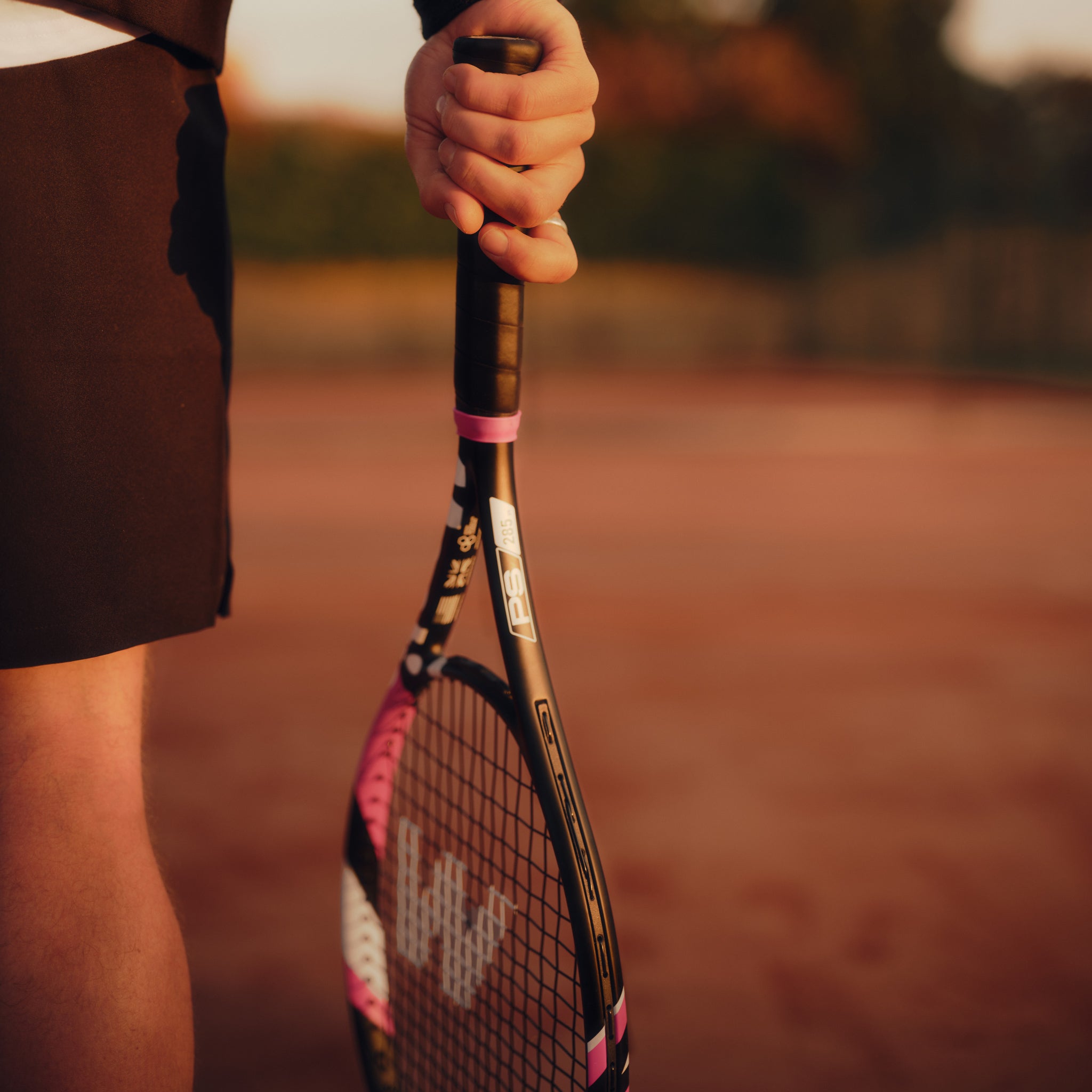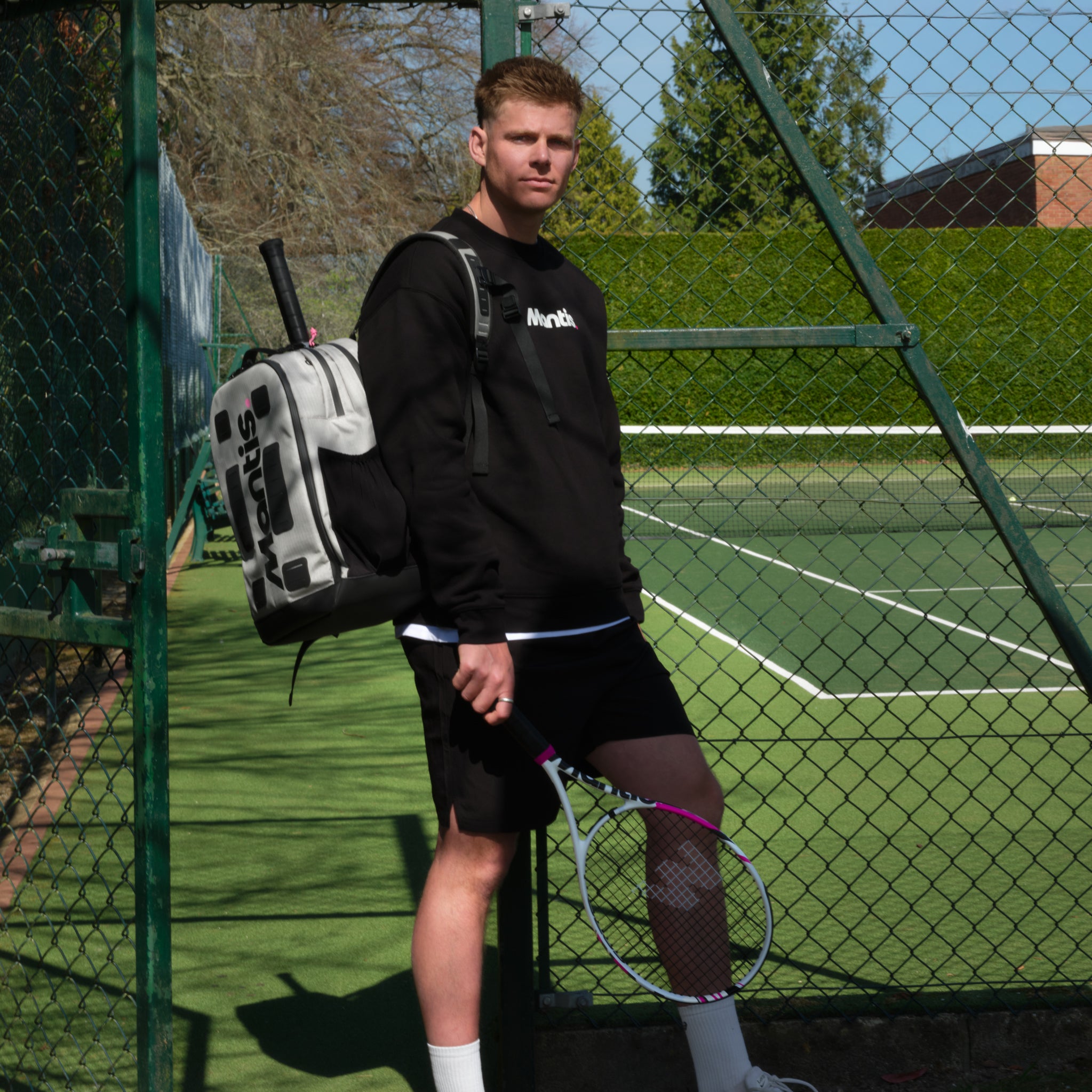
Ever noticed that little rubbery gizmo woven into the strings of a tennis racket? That's a tennis racket dampener, and as we explore in our comprehensive guide to tennis racket technology, its one and only job is to reduce string vibration. Think of it as a tiny shock absorber for your strings, changing how your racket feels and sounds when you hit the ball, but without messing with your power or control.
What Exactly Is a Tennis Racket Dampener?
If you’ve ever been on court, you’ll recognise that sharp ‘ping’ sound when a ball makes perfect contact with the strings. That sound is caused by high-frequency vibrations shooting through the string bed. Some players are fine with it, but plenty of others find it jarring and distracting. That's where a dampener comes in.
A dampener is a small, light accessory, usually made of silicone or rubber, that you wedge between your racket strings. Its entire purpose is to soak up and quieten those high-frequency vibrations. In doing so, it completely changes the sound you hear with every shot.
Here at Mantis, we design our equipment to give you the best possible feel on the court, and knowing how to use accessories like these is a key part of getting the most out of your gear.
This simple act of absorption turns that high-pitched 'ping' into a much deeper, more solid 'thud'. For many players, this just feels better, creating a more comfortable and satisfying hitting experience that helps them stay focused on the game.
The Core Function Explained
It’s crucial to understand that a dampener is all about comfort, not performance. By adding a tiny bit of mass to the strings, it interrupts the vibrational waves that ripple out the instant the ball hits. So, let’s be clear about what a dampener does and what it doesn't.
- It Mutes Sound: The most immediate difference you'll notice is the sound. You get cleaner, more solid feedback on contact.
- It Reduces Vibration: It takes the edge off the high-frequency vibrations that travel from the strings, through the frame, and up your arm.
- It Improves Comfort: By dampening that buzz, it can make playing feel much more pleasant, especially over long matches or tough practice sessions.
A common myth is that dampeners can prevent injuries like tennis elbow. While they certainly make hitting more comfortable by reducing that jarring sensation, they don't absorb the major shock from the ball's impact that can contribute to injury. Their effect is purely on string vibration, not the shock to the racket's frame.
At the end of the day, whether you use a dampener or not comes down to personal taste. It won't add power to your serve or give you more control over your shots. What it does is refine the feeling of playing, helping you connect with the ball by filtering out distracting noise.
The Science of Silencing the Strings
To get your head around how a tiny piece of silicone can quieten a powerful tennis racket, you need to think about sound and energy. Every single time the ball smacks into your strings, it sends a wave of vibrations rippling through the string bed and up into the frame. As a player, you need some of that feedback, but a lot of it is just unwanted noise.
Picture your racket strings like a guitar. When you pluck them, they create different notes, or frequencies. It’s the same deal when a tennis ball makes contact – it generates a whole spectrum of vibrational frequencies. Getting to grips with these is key, and you can dive deeper into their role in our complete tennis string guide. The lower frequencies are what give you that all-important ‘feel’ of the ball, letting you know if you've really connected with the shot.
But that impact also unleashes a torrent of high-frequency vibrations. These are the real culprits behind that sharp, annoying ‘ping’ sound that so many players can’t stand. A tennis racket dampener is engineered specifically to target and mute these high-frequency vibrations, while leaving the crucial lower-frequency feedback pretty much untouched.
How Dampeners Soak Up Unwanted Energy
The real magic is all about converting energy. A dampener is usually made from a soft polymer like silicone or rubber, a material that's brilliant at absorbing vibrational energy. When those high-frequency waves shoot through the strings and hit the dampener, it just soaks them up.
This absorbed energy doesn't just disappear into thin air; it’s converted into a tiny amount of heat. That’s the fundamental principle of how a dampener gets the job done.
Think of a dampener as a sound filter for your racket. It selectively cancels out the harsh, high-pitched notes but lets the deeper, more informative tones pass through, giving you that satisfying and solid 'thud'.
By turning that unwanted vibrational energy into thermal energy, the dampener effectively kills the ‘ping’ and reduces that jarring feeling that can sometimes travel up a player’s arm. This focus on comfort is a huge reason why they’ve become so popular.
The Growing Importance of Player Comfort
The effect this little piece of kit has on a player’s experience is massive, and you can see it in the market figures. The global tennis racket dampener market was valued at around $195.3 million in 2025, with the UK being a major part of that.
This growth is really being pushed by players becoming more aware of the benefits of greater comfort and cutting out distracting vibrations, which can ultimately sharpen your focus during a match. Here at Mantis, we see this as a fantastic trend. It shows that players are paying more attention to the fine details of their equipment to get the absolute most out of their time on court.
What Are the Real Benefits of Using a Dampener?
So, we know what a tennis racket dampener does in theory, but what does that actually mean for your game? At Mantis, we're all about equipment that genuinely improves your time on the court, like the options discussed in our complete tennis string guide. A dampener is a perfect example, delivering some really noticeable perks centred on sound, comfort, and feel. For many players, once they try one, going back to playing without it is a non-starter.
The first thing you’ll notice is the sound. That classic, high-pitched ‘ping’ of the strings is instantly muted, replaced by a much deeper, more satisfying ‘thud’. This isn't just about making the racket quieter; it’s about getting cleaner feedback. A more muted sound helps you connect more intuitively with how well you’ve struck the ball.
Think about it – a clean hit right in the sweet spot has a solid, reassuring tone. A shank, on the other hand, sounds completely different. By filtering out the distracting string vibrations, a dampener helps you tune into these crucial audio cues.
Enhanced Comfort and a More Solid Feel
Beyond the sound, reducing those string vibrations has a direct impact on comfort. During a long match or a tough practice session, that constant high-frequency buzz travelling up your arm can really add to fatigue. A dampener just takes the edge off, making impact feel that little bit smoother.
This is what players mean when they talk about a more ‘solid’ or ‘plush’ feel. The connection with the ball feels cleaner because all that jarring, secondary noise is gone. It allows you to focus purely on the feedback that matters – the ball compressing against the strings – rather than the racket’s noisy reaction.
It’s really important to be clear on one thing: the link between dampeners and tennis elbow. While they absolutely improve comfort by muffling string vibrations, they are not a medical device. Think of them as a fantastic comfort aid, but not a cure or a preventative measure for injury on their own. Proper technique and conditioning are always king.
The popularity of these little accessories speaks for itself. Tennis participation is on the rise here in the UK, and market data shows that vibration dampeners are a huge hit, especially with amateur players who make up over 70% of the playing community. There's a growing awareness around comfort and injury prevention, which has created a real demand for better dampener technology.
Key On-Court Advantages
To wrap it up, popping a dampener on your strings offers a few very practical upgrades to your game. It won’t add a single mph to your serve, but it will refine the feel of every shot you play.
- Better Auditory Feedback: Trading that tinny ‘ping’ for a solid ‘thud’ makes it easier to hear when you’ve hit the ball cleanly.
- Reduced Arm Fatigue: Taking the sting out of the string vibrations can make those long hitting sessions feel less taxing on your arm.
- A More Connected Feel: By muting the background noise, you can really zero in on the sensation of the ball on the string bed.
Ultimately, whether you use a dampener is a personal choice. It’s a small, simple tweak aimed at making your time on court more comfortable and focused. And for such a tiny piece of equipment, it can make a surprisingly big difference to how much you enjoy your tennis.
Comparing Different Types of Dampeners
Not all tennis dampeners are made the same, and picking the right one really boils down to personal feel and how much feedback you want from your strings. At Mantis, we know that understanding your options is the first step to finding that perfect on-court feel, a concept we also cover when discussing the role of a tennis racket shock absorber. The two styles you'll see most often are the 'button' and 'worm' dampeners, and they each offer a completely different experience.
Button dampeners are the small, compact ones you see, usually shaped like a circle or an oval. They're designed to pop snugly between two of the main strings, right below the lowest cross-string. This means they only touch a very small area. The result is a subtle dampening effect—it gets rid of that harsh ‘ping’ without completely killing the sensation of the ball hitting the strings.
Worm dampeners, as the name suggests, are long and snake-like. You weave these through several of the main strings, so they cover a much larger patch of the string bed. Because they make so much contact, they provide maximum vibration absorption. This gives you a much more muted and dampened feel, which is perfect for players who prioritise comfort over everything else.
Button Dampeners: The Popular Choice
Button dampeners are incredibly popular, mainly because they’re simple and offer a really balanced feel. They’re a breeze to pop into place and usually stay put, even during intense rallies. By only touching a couple of strings, they manage to filter out the most unpleasant high-frequency vibrations while still letting you feel connected to the ball.
This style has become a real favourite here in the UK tennis community. In fact, by 2023, button-type dampeners were the top sellers in the UK, mostly because they work well and last a long time. With around 65% of UK players who use dampeners being amateurs focused on comfort, the button style just hits that sweet spot.
Worm Dampeners: For Maximum Absorption
If what you're after is the biggest possible change in sound and feel, then a worm dampener is the way to go. Weaving it through several strings creates more contact points to soak up the energy from the impact, leading to a profoundly quiet response. This is a great choice for any player who finds even the slightest string vibration uncomfortable or distracting.
Think of it like adjusting the volume on a speaker. A button dampener turns it down a bit, just enough to clean up the sound. A worm dampener, on the other hand, is like hitting the mute button—it gives you the quietest experience possible.
Comparison of Tennis Dampener Types
To make your decision a little easier, we’ve put together a quick comparison table that lays out the key differences between the two main styles.
| Dampener Type | Installation Method | Level of Dampening | Pros | Cons |
|---|---|---|---|---|
| Button | Snaps between two strings | Moderate | Easy to install, preserves some string feel, secure | Less dampening than a worm, can be lost if it pops out |
| Worm | Woven through multiple strings | High | Maximum vibration absorption, very muted sound | Trickier to install, can alter the string bed feel more noticeably |
Ultimately, the best way to know which one is for you is to try them both out and see what feels right for your game.
How to Choose and Install Your Dampener
Picking the right tennis racket dampener is all about personal preference and the kind of feel you're chasing on court. Here at Mantis, we always encourage players to ask themselves a simple question: what do you want your racket to feel like at impact?
Are you aiming for maximum comfort to soothe your arm, or do you prefer to keep as much of that raw string feedback as you can? Your answer really narrows down the options.
If you're all about comfort, the ‘worm’ style dampener is a fantastic choice. It snakes its way across several strings, soaking up a huge amount of vibration and delivering a really solid, muted thud on impact. But if you just want to get rid of that harsh, tinny ‘ping’ without losing your connection to the ball, a simple ‘button’ dampener is perfect. It works on a smaller scale, silencing the worst of the vibrations but still letting you feel the shot.
If you'd like to dive deeper into how different bits of kit can change your racket's performance, you can learn about the role of a tennis racket shock absorber in our other guide.
Proper Installation and Placement
Got your dampener? Great. Now, putting it on correctly is crucial—not just to make it work, but also to stay within the official rules of the game. The International Tennis Federation (ITF) is quite specific about where you can and can't place one.
The official ITF rulebook states that any device changing a racket's playing characteristics, dampeners included, must be placed outside the pattern of the crossed strings. Essentially, you can't stick it right in the middle of the sweet spot.
This rule exists to keep the playing field level, ensuring no one gets an unfair advantage from their equipment. So, where does it go? The most popular and effective spot is just below the bottom cross-string, nestled right between the two centre-most main strings.
Step-by-Step Installation Guide
Getting your dampener fitted is straightforward. Here’s the simple Mantis method to get a secure fit that won't budge, even during the most frantic rallies.
- Step 1: Find the right spot. Look for the area on your strings just beneath the very last horizontal (bottom) cross-string.
- Step 2: Position the dampener. For a ‘button’ type, just push it between the two central main strings. You’ll feel it click or pop into place as the grooves catch the strings.
- Step 3: Weave it in. If you're using a ‘worm’ dampener, start at one of the central main strings and weave it over and under the next few strings until it's snug.
- Step 4: Give it a quick check. Gently pull on it to make sure it's secure. The last thing you want is for it to fly off mid-point and cause a distraction.
Follow these simple steps, and your dampener will be legally placed, secure, and ready to give you the improved feel and comfort you’re looking for.
Let's Bust Some Common Dampener Myths
When it comes to tennis racket dampeners, there’s a lot of chatter on the court, and frankly, not all of it is true. Here at Mantis, we want to cut through the noise and give you the real story about these little accessories, just as we did in our guide to tennis racket technology. So, let’s clear the air and tackle some of the biggest myths you’ve probably heard. You can also consult with an expert coach if you want some added assurance.
The most common one? That a dampener will magically add more power or control to your shots. While it might feel like you're more connected to the ball, this is purely down to a change in sensation. A dampener's mass is tiny—we're talking just a few grams—so it has no real, physical impact on your swing or how the racket performs.
Another one we hear all the time is that a dampener can make the sweet spot bigger. Again, this is a myth. The sweet spot is part of the racket's fundamental design, determined by its frame and string pattern. Sticking a small piece of rubber on the strings simply can't change those physics.
The Big One: Injury Prevention
This is perhaps the most important myth we need to bust: the idea that a dampener can prevent or even cure tennis elbow. This is fundamentally untrue. Dampeners are brilliant at what they do – reducing that high-frequency 'ping' from the strings to make hitting more comfortable. However, they do nothing to absorb the much larger shock that travels up the frame and into your arm when you hit the ball.
Think of a dampener as a tool for comfort, not a medical device. It's there to improve the feel and sound of your game, but it won't fix underlying technique problems or prevent stress injuries like tennis elbow.
Imagine it like this: a dampener makes the sound of impact more pleasant, but it doesn't reduce the actual force of the collision. Preventing injuries is all about using proper technique, staying conditioned, and choosing a racket that's right for your body and playing style.
By understanding what a dampener really does (and doesn't do), you can make a much smarter choice. It's a fantastic little bit of kit for improving the sound and feel of your game, but it's not a magic fix for your performance or your health.
Common Questions About Dampeners
To wrap things up, we at Mantis wanted to tackle a few common questions that pop up when players are considering a dampener. While some gear choices can feel overwhelming, figuring out if a tennis racket shock absorber is for you is thankfully pretty straightforward.
Do All the Pros Use a Dampener?
Not at all. Whether you use a dampener is purely down to personal preference, and that’s true even at the very top of the sport. You'll see players like Novak Djokovic and Rafael Nadal with a dampener on their strings every time they step on court—they clearly prefer that muted sound and feel.
But on the flip side, you have legends like Roger Federer and Andre Agassi who famously played without one. They preferred the raw, unfiltered feedback straight from the string bed. It just goes to show there’s no right or wrong answer, only what feels best for your game.
How Do I Know If I Need One?
Honestly, the only way to know for sure is to try one out. If you’ve never used a dampener, borrow one or pick up a cheap one and play a few sets. Really pay attention to the difference in sound and how the racket feels at impact.
Do you prefer the solid ‘thud’ over the high-pitched ‘ping’?
A dampener isn't about hitting the ball harder or with more spin; it’s all about comfort and the sensory feedback you get from the racket. If the reduced vibration feels better and helps you feel more connected to your shots, then it's a great little addition.
Ultimately, your own on-court experience is the best guide.
Can I Just Use a Rubber Band?
You absolutely can. Tying a simple rubber band around your strings is a classic, effective, and completely legal DIY dampener. Just wrap it tightly around the two centre main strings, right below the bottom cross-string.
It works on the exact same principle as a purpose-built dampener by adding a tiny bit of mass to the strings to quieten those high-frequency vibrations. Plenty of pros have been known to use this simple trick over the years.
At Mantis, we believe your gear should be an extension of your ambition. We craft high-performance equipment with a focus on purposeful design, allowing you to fine-tune every detail for the perfect on-court feel. Explore our range of rackets and accessories designed for players who live for progress. https://mantissport.com








